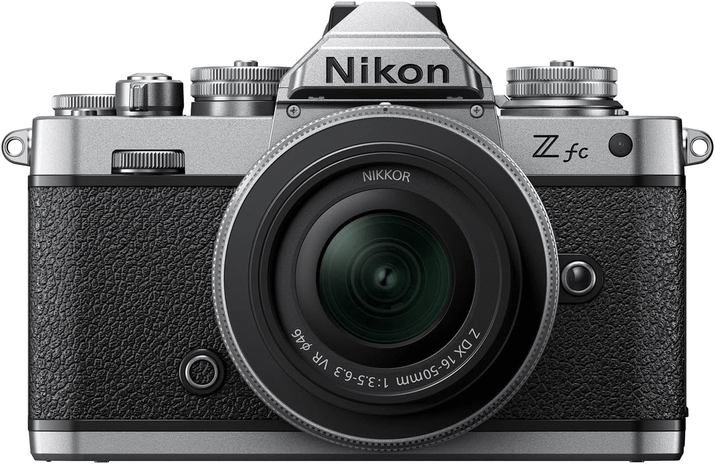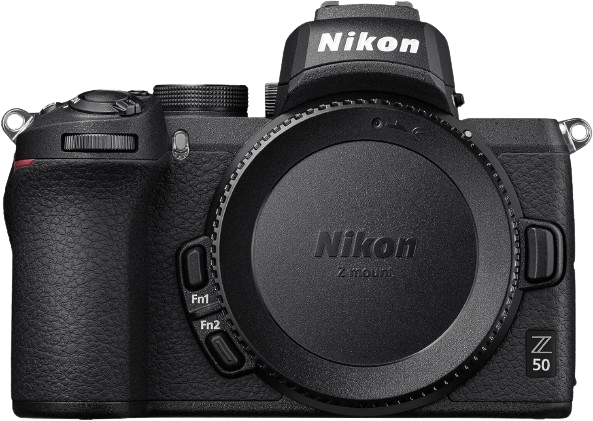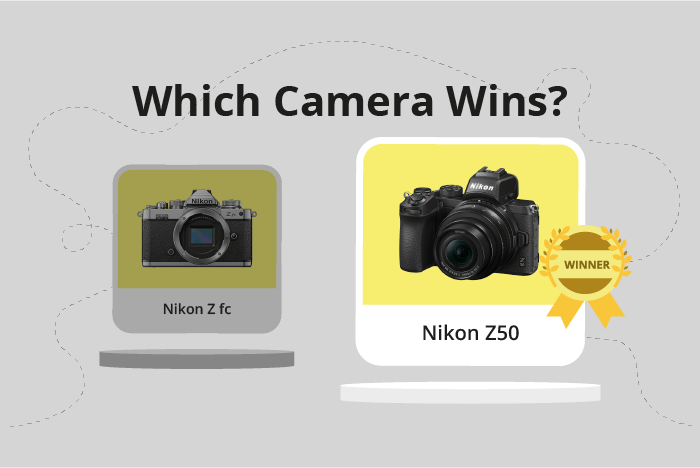Nikon Z fc vs Z50 Comparison
Nikon Z fc

Nikon Z50

The Nikon Z50 slightly outperforms the Nikon Z fc with a score of 73/100 compared to the Z fc’s 72/100. Both cameras share similarities as mirrorless models, released in 2019 and 2021 respectively. The Z50 has a lower launch price of $859, while the Z fc is priced at $959.
The Z fc stands out with its smaller and lighter body, measuring 135 x 94 x 44mm and weighing 445g. In contrast, the Z50 measures 127 x 94 x 60mm and weighs 450g. Although the Z50 is slightly heavier and bulkier than the Z fc, it wins by a narrow margin in our scoring system.
Taking these factors into account, the Nikon Z50 offers better value for money, while the Nikon Z fc provides a more compact and lightweight option for photographers. Each camera has its unique advantages, catering to different needs and preferences.
Nikon Z fc vs Z50 Overview and Optics
The Nikon Z fc and Nikon Z50 both receive a score of 72/100 for optics, indicating that they are evenly matched in this aspect. Both cameras share several specifications, including 21 megapixels, an 11 FPS shooting speed, a CMOS sensor type, an Expeed 6 processor, a DXOMARK score of 97 for the sensor, an APS-C sensor size, a Nikon Z lens mount, and no image stabilization.
Despite the identical scores, there are areas where one camera may appear to have an advantage over the other. However, the specifications listed above show that there are no significant differences in the optical performance of the Nikon Z fc and the Nikon Z50. Both cameras provide the same level of image quality, speed, and sensor performance.
It is important to note that the score does not determine the quality of the camera, but rather the camera is awarded a higher score because of its better performance. In this case, both cameras have the same score for optics, meaning that neither camera outperforms the other in terms of optical specifications.
Taking all of these factors into account, it is clear that the Nikon Z fc and Nikon Z50 are on equal footing when it comes to optics. The identical features and performance of both cameras make it difficult to declare a winner in this comparison. Ultimately, the decision between these two cameras will come down to individual preferences and needs, such as design, ergonomics, and other features not directly related to optics.
Nikon Z fc vs Z50 Video Performance
The Nikon Z fc and Nikon Z50 both have a video score of 91/100, indicating that these cameras have similar video capabilities. They share common specifications such as 4K max video resolution, max video dimensions of 3840 x 2160, and a max video frame rate of 120fps. Additionally, both cameras have built-in time-lapse functionality.
Despite having the same video score, there are areas where one camera may outperform the other. The Nikon Z fc has specific features that make it a better choice for certain users. However, the Nikon Z50 also has its own advantages, making it a suitable option for different users.
The Nikon Z fc is known for its retro design and superior ergonomics, making it more comfortable to hold and operate for extended periods of video shooting. This makes it an ideal choice for users who prioritize comfort and ease of use while capturing video.
On the other hand, the Nikon Z50 is a more compact and lightweight camera, making it a better option for those who need a portable and travel-friendly camera for their video needs. The smaller size of the Z50 allows for easier transport and storage, which is essential for users who are constantly on the go.
Both the Nikon Z fc and Nikon Z50 offer excellent video capabilities, and the choice between them depends on the user’s preferences and needs. The Z fc is ideal for those who value comfort and a retro design, while the Z50 is perfect for those who require a compact and lightweight camera for their video requirements.
Nikon Z fc vs Z50 Features and Benefits
The Nikon Z50 takes the lead in the features comparison with a score of 86/100, while the Nikon Z fc follows closely with a score of 83/100. Both cameras share several features, ensuring a strong foundation for their performance. These common specifications include a 1,040,000-dot screen resolution, touchscreen capability, flip screen, absence of GPS, and the presence of both WIFI and Bluetooth connectivity.
The Nikon Z50 comes out ahead with its larger screen size of 3.2 inches, compared to the Nikon Z fc’s 3-inch screen. This additional screen real estate allows for easier framing, reviewing, and editing of photos, providing a better user experience.
On the other hand, the Nikon Z fc does not surpass the Z50 in any specific feature; however, it closely matches the Z50’s performance with only a slight difference in the overall score. This indicates that the Nikon Z fc is still a strong contender in the features department.
To conclude, the Nikon Z50 emerges as the winner in this comparison due to its larger screen size, offering a better viewing and user experience. The Nikon Z fc, though not surpassing the Z50, remains a competitive option with a near-identical feature set. Ultimately, both cameras provide a solid foundation of features for photographers to work with, and the choice between the two will depend on individual preferences and priorities.
Nikon Z fc vs Z50 Storage and Battery
The Nikon Z50 emerges as the winner in the storage and battery comparison, scoring 35/100 while the Nikon Z fc scores 29/100. Both cameras share common specifications such as a single memory card slot, compatibility with SD/SDHC/SDXC (UHS-I) memory cards, the use of EN-EL25 batteries, and USB charging capabilities.
The Nikon Z50 outperforms the Z fc in battery life, offering 320 shots per charge compared to the Z fc’s 260 shots. This advantage allows users to capture more images before needing a battery replacement or recharge, making it more convenient for extended photography sessions.
The Nikon Z fc, despite having a lower score, does not offer any advantages over the Z50 in terms of storage and battery. Both cameras share the same memory card compatibility and charging options.
In this comparison, the Nikon Z50 clearly provides better battery life than the Nikon Z fc. As a result, the Z50 is more suitable for photographers who require longer shooting times without the need to change or recharge batteries.
Nikon Z fc vs Z50 – Our Verdict
Are you still undecided about which camera is right for you? Have a look at these popular comparisons that feature the Nikon Z fc or the Nikon Z50:

